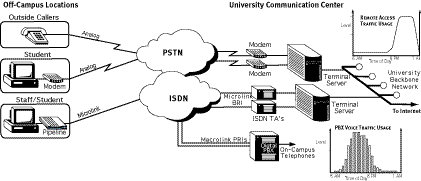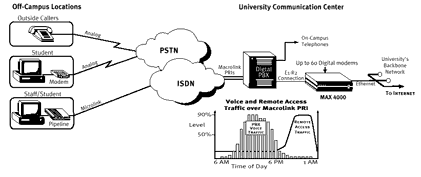
Sales Tools

Australian University Combines Voice and Remote Access over ISDN PRI and Saves Money
| Background A recent surge in enrollment at a prestigious Australian university has brought with it increasing demand for the school's computing resources. Also contributing to the demand is the growing number of students living off-campus who need access to the campus network to perform library research, turn in assignments electronically or connect to the Internet. To meet its remote access demands, the university's communications group several years ago installed a rack of analog modems and two dozen analog circuits. They also purchased a handful of ISDN terminal adapters to accommodate the small number of students and employees with ISDN lines and high-bandwidth needs. As the university's remote access needs have continued to increase, the modem/terminal adapter solution has proven inadequate. Modem users frequently experienced line noise and lost connections. And the communications group complained that modems and terminal adapters were difficult to troubleshoot, costly to maintain and take up lots of space in their equipment racks. |
Application
Current Approach The Need |
Australian University - Previous Network

The Solution
To solve the dilemma, communications group staff decided to take a close look at the university's existing communications infrastructure. Data traffic from remote callers, they noted, starts up around 6 PM -- when classes are over and students and staff has gone home -- then continues steadily until around 11 PM. But by morning, as students and staff return to campus and classes begin, data traffic is at a standstill.
Voice traffic, on the other hand, follows the opposite pattern. The number of voice calls peaks during the day, when administrative offices are open and classes are in session. Then at 5 PM voice traffic plummets, with only a few phone calls placed during the evening and early morning hours.
Based on this analysis, the communications group devised an ingenious remote access solution that takes advantage of the daily fluctuation in the school's voice and data traffic. During the evening they decide to route data traffic from remote users over the same ISDN PRI access line that carries voice traffic during the day. In the morning, the access lines used for data are automatically reallocated to voice traffic.
How it Works
The linchpin of the new solution is an Ascend MAX 4000 with 60 digital modems and the school's digital PBX. The MAX 4000 is connected behind the PBX using two E1/R2 connections. Now, to access on-campus computer resources remotely, students and staff simply dial a phone number that corresponds to a bank of sixty 64-Kbps channels on the digital PBX. The PBX sends the remote users' call over the E1/R2 connection to an E1 port on the MAX. The MAX, in turn, routes the call through its Ethernet port to the campus LAN or the school's Internet gateway, giving students access to the campus network as if they were locally connected.
Because the MAX can support both analog and ISDN callers at the same time, the university has been able to eliminate its cumbersome assortment of modem racks and terminal adapters that are difficult to manage. Digital modem cards installed in the MAX provide full access to dial in users and better performance than analog modems. WAN interface cards in the MAX process the handful of callers using ISDN lines and terminal adapters.
| As more remote callers
start using ISDN, the communications group staff can
easily swap out the digital modem cards in the MAX for
additional WAN interface cards, allowing a smooth
migration from analog to digital services. At the remote
sites, the Universtiy has began deployment of the
Pipeline product which provides IP/IPX routing at an
affordable price. The university's new remote access solution provides a number of advantages over its old remote access method. By allowing voice and data traffic to share existing ISDN access lines, the school has reduced its telecommunications costs substantially. By installing standards-based equipment that is easy to manage, troubleshoot and maintain, the school has lowered its operational costs. And by offering an all-digital solution, the school provides its remote callers with a higher quality of service. |
Ascend Equipment
The Benefits |
Australian University -
Ascend Solution

Copyright ©1998 Ascend Communications, Inc. All rights reserved.
![]()